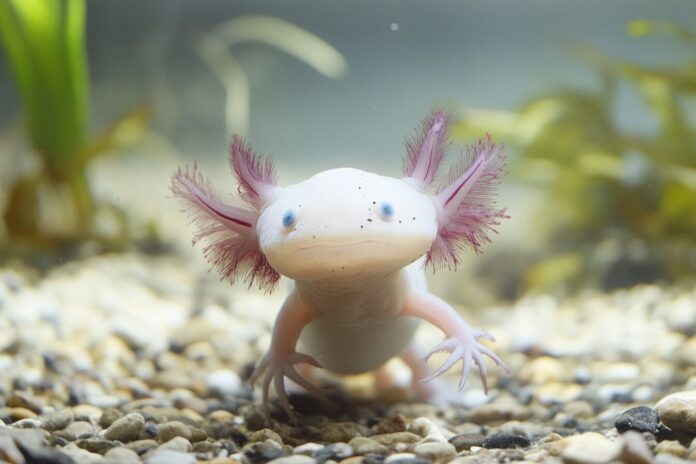Unraveling Nature’s Regeneration Blueprint
Axolotls, the fascinating salamanders native to Mexico, have long mesmerized both scientists and the public. Most importantly, their ability to regrow entire limbs—sometimes even parts of the spinal cord and organs—seems straight out of science fiction. Because of this, researchers worldwide are intensely studying these creatures to unlock secrets that could change regenerative medicine.
Recent studies, such as those discussed by Northeastern University and the Smithsonian Magazine, have emphasized that understanding axolotl regeneration may pave the way for breakthrough human therapies. Therefore, scientists are not only intrigued by the sheer biological marvel these animals represent but are also motivated by the possibility of applying these lessons to repair human tissues and organs.
The Power of Retinoic Acid
For decades, biologists have tirelessly worked to answer one crucial question: how does an axolotl know what to regrow and when? The answer appears to be linked largely to retinoic acid, a derivative of vitamin A that plays a central role in signaling developmental cues. Because retinoic acid coordinates cell growth and tissue patterning, it functions almost like a master architect during limb regeneration.
In groundbreaking experiments, scientists engineered axolotls to glow under specific conditions, thereby enabling them to trace the distribution and influence of retinoic acid in real-time. When researchers increased levels of retinoic acid, the salamanders unexpectedly produced duplicate limbs rather than simply restoring the lost part. This unexpected outcome shows that retinoic acid not only triggers regrowth but also meticulously directs the process, ensuring that the correct tissue types and structures form precisely where needed. More insights on this phenomenon are detailed in both the research highlights on the NIH website and reports in Popular Science.
Genetic Pathways and Molecular Signaling
Besides the influence of retinoic acid, axolotls employ a finely tuned network of genetic pathways to orchestrate regeneration. Because genes such as Hand2 and signaling proteins like Shh are activated during regrowth, they help determine the identity and spatial organization of new cells. Most importantly, these pathways ensure that the new tissues are structurally sound and functionally integrated with the existing anatomy.
Recent findings published by Technology Networks have confirmed that disruption in these genetic signals can lead to misformation or incomplete limb structures. Therefore, the precise regulation of these molecular signals is critical for complete and faithful regeneration. These studies reveal that, in axolotls, the interplay between retinoic acid and genetic signaling creates a regenerative orchestra where every element plays a crucial role.
A Regenerative Orchestra: More Than One Key
It is now evident that there is no single mechanism behind axolotl limb regeneration. Instead, several overlapping processes work in concert—from chemical signals such as retinoic acid to the activation of complex gene networks. Because each component has a specific function, the entire process resembles a well-rehearsed symphony of biological events.
In addition, many of the genes and signaling pathways active in axolotl limb regrowth are also present in human DNA. However, humans lack the ability to reactivate these genes during adulthood, presenting both a challenge and an opportunity for regenerative medicine. This overlapping genetic toolkit offers new avenues for research, as highlighted by studies from the NIH and Smithsonian Magazine, because replicating this process in humans might one day lead to revolutionary therapies.
New Tools and Technologies in Regeneration Research
Because scientific inquiry often builds on technological advancement, researchers are increasingly utilizing cutting-edge genetic engineering techniques. For example, innovative methods involving gene editing and fluorescent tagging of tissues have allowed scientists to visualize the regeneration process in unprecedented detail. Most importantly, these visual tools offer not only evidence of cellular activity but also new insights into the timing and coordination of gene expression during regeneration.
Moreover, advanced imaging and molecular tracing techniques have been deployed to capture the dynamic changes occurring during limb regrowth. This technological progress, documented by both Northeastern University and Technology Networks, provides an exciting framework for understanding and eventually replicating these processes in medical applications for humans.
Implications for Human Medicine
The discovery of the molecular and genetic foundations of axolotl limb regeneration has revived hope in the field of human regenerative medicine. Because axolotls share a significant portion of their genetic makeup with humans, these findings are laying the groundwork for potential treatments to repair nerve damage, restore limb function, and address organ failure. Therefore, research is now shifting focus from the animal model to potential human applications.
Additionally, scientists are exploring strategies to mimic the axolotl’s regenerative processes in mammals. Innovative approaches include the controlled use of retinoic acid and the fine-tuning of genetic pathways during the healing process. Although replicating axolotl regeneration in humans presents substantial challenges, the progress in this field is groundbreaking. As noted in the NIH research highlights and discussed in Smithsonian Magazine, the long-term goal is to develop therapies that could transform traditional medical treatment in ways previously thought impossible.
Conclusion: A Future Fueled by Salamander Science
Axolotls are teaching us that regeneration is not magic—it is a result of precise chemical signals and genetic choreography. Because these discoveries continue to unfold, every breakthrough brings humanity one step closer to harnessing nature’s secrets for therapeutic purposes. Most importantly, this research has the potential to revolutionize our understanding of healing and tissue regeneration.
Looking forward, scientists are enthusiastic about applying the lessons learned from axolotls to human medicine. With new techniques and a deeper understanding of the interplay between retinoic acid and genetic signals, the dream of regrowing lost limbs or damaged organs may one day become a reality. Therefore, the continued study of these unique salamanders is vital for both biological science and the future of regenerative medicine.
References
- Northeastern University News: How Do Axolotls Regenerate Their Limbs?
- NIH: The Amazing Axolotl: A Valuable Model for Regenerative Medicine
- Smithsonian Magazine: Axolotls May Hold the Key to Regrowing Limbs
- Technology Networks: Axolotl Limb Regeneration Controlled by Hand2-Shh
- Popular Science: A Chemical in Acne Medicine Can Help Regenerate Limbs



